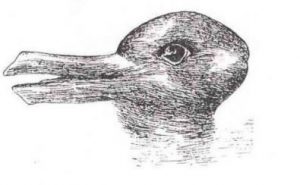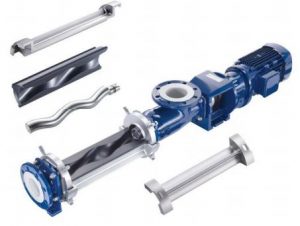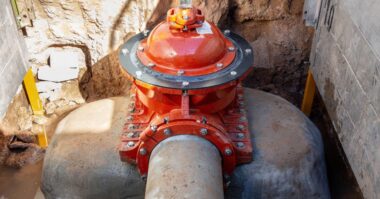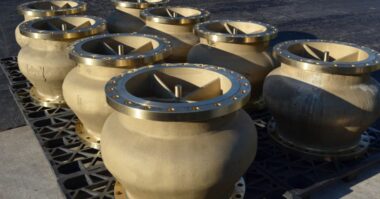A paradigm shift is a change from one way of thinking to another. It does not just happen, but rather it is driven by agents of change. Do you see a duck or a rabbit in the Joseph Jastrow’s classic photograph above (first published in Popular Science Monthly in 1899)? You may see a duck or you may see a rabbit, but there is a distinct possibility that at first glance you decided what the image was, and that is how you will continue to decipher the image going into the future unless your point of view is prompted to change. There are current paradigms, or methods of thinking, that need to shift because they limit progressive cavity pump (PCP) usage in chemical processes. For many the logic is to utilize a centrifugal pump and control valve for flow control and to utilize a PCP only for pumping high viscosity media. However, PCPs are particularly well suited for chemical applications due to their valveless design, controllable flow and low pulsation. The term for this innovative use of PCPs in such applications has been coined “valveless flow control”. In order to cajole a paradigm shift from the conventional use of centrifugal pumps with control valves, the many advantages of and opportunities for valveless flow control with a PCP must be revealed and easily identified.
Various ranges of PCPs can gently meter and convey fluids of any viscosity, in a wide range of temperatures (especially with even wall stators), with or without solids. In a PCP, a single helix rotor turns insides a double helix stator to create cavities which progress from the suction to discharge. The compression fit between the rotor and the stator creates seal lines that keep the cavities separate as they move through the pump with each rotation. The compression enables the pump to act like a valve. The result is flow with very little pulsation and low shear rates. Slip is less of an issue and when the pump stops nothing will flow through it. The compression between the rotor and stator enables customers to mount the pumps vertically. Non suspended solids in slurries won’t settle in the pump casing and cause wear issues when pumps are mounted vertically.
Typical applications where PCPs can replace centrifugal and control valve combinations include wastewater treatment, chemical metering applications, and any application in which flow control is vital. For example, an application transferring slurry to a blending tank would typically prompt the need for a centrifugal pump and a control valve to control flow. Centrifugal pumps are a very common type of pump that includes a shaft-driven impeller that rotates inside a casing. Liquid flows into the suction port, or inlet, of the casing and is propelled to the outside of the casing, exiting through a discharge port. Centrifugal pumps are designed for high flow applications and conveying liquids with relatively low viscosity with consistencies like water or like very light oil. A flow control valve regulates the flow or pressure of a fluid and is generally incorporated as the final element of a control loop to control flow within the required operating range. Such valves can be identified as pressure regulators and flow control, altitude, or relief valves. They can be fitted with actuators or can be automatic which do not require an external power source. Common issues with centrifugal and control valve combinations include cavitation, leaks, obstructions, erosion, hysteresis and modulation. Centrifugal pumps can lose prime between batches or from alternating pumps. If a valve fails the only choice is to repair or replace it.
Valves could be eliminated altogether. When considering process control, a progressive cavity pump, flow meter, and Variable Frequency Drive is much simpler than a centrifugal and valve combination. The PCP self-primes and acts as a pump and control valve in one, providing much better flow control. Recent innovations in PCP technology and the success of several flow control installations at chemical process plants has resulted in proof that using a PCP improves performance and cuts costs. PCP advantages include reliability, reduced maintenance, capital, and operating and energy costs. Also important, PCPs can be made from specialty materials resistant to abrasive or corrosive chemicals. A PCP can solve a multitude of flow control issues compared to other pumps that require control valves. PCPs are not affected by changing pressures. There is no worrying about internal or external air leaks or obstructions in the suction or discharge pipework. Hysteresis and modulation can also be virtually eliminated.
Hysteresis is the phenomenon in which the response of a physical property lags behind changes in the effect causing it. Hysteresis increases when the stem seal (usually packing) in a control valve is tightened to decrease leakage. Additional force is eventually required to overcome the seal’s resistance to movement, which results in modulation and less than precise flow control. Control loops depending upon control valves usually see hysteresis as dead-time in their dynamic response and will compensate by applying additional reset action. When the hysteresis becomes too large, the control loop may become unstable, oscillating about the setpoint more than desired. The “cure” is to rebuild the control valve – a costly maintenance operation. Using a PCP with a VFD is a solution to reduce hysteresis. A historical graph produced by a control room illustrates the difference a PCP makes when it comes to flow control.
The graph shows the control valve modulating as it tries to respond to the flow setpoint, which leads to a wavy line. The centrifugal and control valve combination was taken offline just before 11 a.m. and replaced with a PCP. The data showed the PCP’s flow rate “flatline” and the difference is obvious. The PCP reliably displaced an exact volume per revolution and was not as affected by downstream pressure changes, leading to highly reliable flow control.
So how much will a paradigm shift to reliable valveless flow control cost? When comparing the costs of both potential flow control solutions, be sure to compare the cost of a PCP to the combined cost of a centrifugal pump and control valve. The cost of a complex control valve and actuator combined with a centrifugal pump often exceeds the cost of a PCP by 1.25 to 1.5 times. You should also consider lifecycle costs including capital, operating, maintenance costs as well as energy costs. Typically, centrifugal pumps are easy to maintain (whereas control valves are not so easy because an entire separate set of calibration and diagnostic techniques comes into play), but a progressive cavity pump with Smart Conveying Technology (SCT) is extremely easy to maintain.
By separating the stator into two halves with this proprietary innovation, PCPs with SCT will reduce service times substantially and no longer have to be removed from the installation for maintenance. Dismantling and reassembly of piping and the removal of other equipment components is eliminated. There are reductions in time and effort required to replace worn components. Additionally, the SCT design allows the stator to be re-adjusted, giving longer stator and rotor life. This is due to the integrated retensioning device. A simple readjustment of the stator increases the service life of stator and rotor and lowers lifecycle costs by reducing service time and parts costs. A PCP also lowers lifecycle costs by reducing energy costs. Although modern control valves are more sophisticated, the power medium is often compressed air, one of the most expensive sources of energy in a plant. Electric actuators are quickly becoming a popular alternative as plants seek ways to reduce energy costs and offer precision, but retrofit is costly.
The centrifugal pump’s best efficiency point should also be considered. Calculate HP for 20, 40, and 60 GPM using the 8.5” impeller vs. a SEEPEX 17-6L. Although starting HP on the SEEPEX is higher (for a brief second), BHP is lower. A typical control valve using a spring diaphragm actuator takes a 4-20 mA signal to position the valve. This signal is then converted to a pneumatic signal which increases or decreases the pressure to the spring diaphragm actuator. This mix of electric and pneumatic technology often results in unstable flow control when compared to a PCP. As a standard rule of thumb, a PCP will provide better efficiency when PSI is greater than the GPM. This makes PCPs ideal for flow control applications requiring low flows and high pressures. A seepex BN 17-6L PCP has much better efficiencies than a centrifugal pump.
This leads to another issue; turn down, which PCPs are apt to handle more of without deadhead or running out on the curve when trying to achieve a wide range. Again, a control loop consisting of a PCP, variable frequency drive, and flow meter is simpler. A VFD can take the place of a pneumatic controller. Pump speed controls the flow. Response time is immediate and hysteresis is dramatically reduced and virtually eliminated, invoking a flat line on a flow chart indicating more precise dosing and mixing which results in better quality control. This may lead to consideration of other options like eliminating batch mixing in blend tanks and going with more cost effective continuous, on-line blending. Multiple component inline blending is a popular application for pc pumps because multiple components can be precisely metered continuously, without slip, and without pulsations.
So, please look at Jastrow’s classic photograph again and think about which animal you saw when you first began reading this article. If at first you chose duck, maybe now you can begin to identify the outline of a bunny’s face, facing the right. Do you see its wiggling upturned nose and two pin straight ears? If at first sight you chose bunny, can you now see how it very well may be a duck looking to the left? Can you almost hear “quack, quack!” coming from its slightly opened beak? The point is it doesn’t matter which animal you interpreted at first glance. What matters is that you can now see the possibility that it could be something else, something entirely different once you’ve opened your mind to consider alternatives. Can you change your old way of thinking? Can you be an agent of change in your industry? Consider a progressive cavity pump application next time there is a capital upgrade project at your facility.










Comments